





PHOTO GALLERY

Photos by Len Blumin
1. Gambel's Quail - Callipepla gambelii
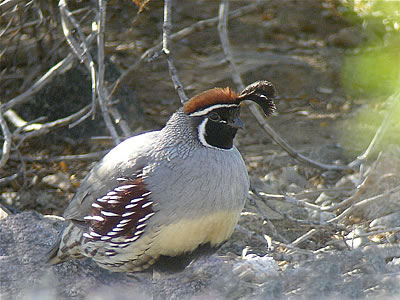
Callipepla means "beautifully robed", and indeed he is. The male Gambel's Quail, Callipepla gambelii, is a bird of the Sonoran Desert, whereas its California Quail cousin is found along the west coast favors less arid habitats. Their ranges overlap in southwestern California, where hybridization can occur. This one from northwest Phoenix, where we stopped to view Bendire's Thrasher.
Gambel's Quail populations are reasonably stable, despite continued hunting. Perhaps the fact that they adapt well to suburban living keeps their numbers up, as many folks put out a "quail block" made of seeds to feed the local coveys. The male shown here seems to have a double "topknot", which is made up of 6 plumed feathers. Maybe the feathers were ruffled by the wind, as the topknot is usually single, as in the California Quail. Gambel's has a pretty cinnamon crown, black face, plain buffy upper belly, black on lower belly, and chestnut flanks. Compare to California Quail, which has a darker and browner crown, pale forehead rather than black, scaling of the feathers on the belly, and dark brown on flanks. Taxonomy below.
Taxonomy - An interesting article in the current issue of ABA's Birding (41:1, JAN 09) summarizes an article by Hackett et. al (Science 320:1763-1768) and suggests that we have to re-shuffle the relationships between the various orders. Game birds such as the Quail are thought to be closely related to the ducks and geese, and both orders likely evolved before Loon, Grebes, and Tubenoses. The 5th edition of the National Geographic Field Guide to Birds of North America has moved both orders to the front of the book.
Order: Galliformes - Game birds and such. Includes Megapodes, Chachalacas, Guans, Grouse, Turkeys, Pheasants, Guineafowl and New World Quail.
Family: Odontophoridae - The New World Quail. 31 species world-wdie, 6 in the U.S., including California, Gambel's, Mountain, Scaled and Montezuma Quails, plus the Northern Bobwhite. The Montezuma Quail is the hardest to find.
Species: Callipepla gambelii - Gambel's Quail. William Gambell (1823-1849) was a naturalist who explored the west collecting birds and plants and was a protegé of Thomas Nuttall. See Mearns' account in Audubon to Xantus.
2. A bird of the ages
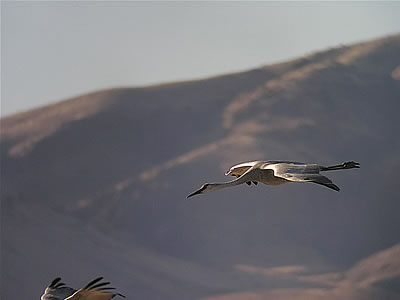
A vision like this could have been viewed millions of years ago in the wetlands of the lower U.S. and Mexico - the majestic and haunting Sandhill Crane gliding in to a protected wetland area at day's end. Their strangely hypnotic bugling still echoes in our minds. Aldo Leopold wrote: "When we hear his call we hear no mere bird. We hear the trumpet in the orchestra of evolution. He is the symbol of our untamable past, of that incredible sweep of millenia which underlies and conditions the daily affairs of birds and men." (Marshland Elegy, 1937 - from Matthiessen's "The Birds of Heaven").
At Bosque del Apache ("woods of the Apache"), along the Rio Grande south of Albuquerque, over 10,000 Sandhill Cranes (Grus canadensis) gather each winter. I have read about this mecca of birding for years, and only regret that we've not visited earlier. Cranes, Geese, Ducks, and Raptors provide a spectacle that changes each hour and each day. Always different, always memorable. Would that I could attach sound to the photo.
3. Harlequin Duck - Histrionicus histrionicus
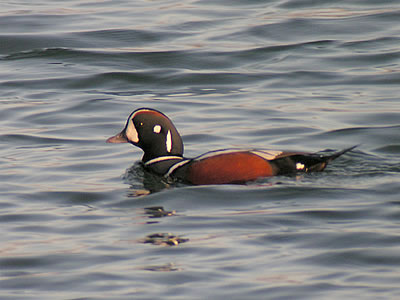
The "harlequin" was a theatrical clown wearing a brightly colored costume. "Histrionicus" refers to the theater, again suggesting a stage costume. And a fine costume it is the male Harlequin wears, as seen here on one that spent some time recently near the Salute Restaurant in the Richmond Marina. Marginal photo because of low light and fast swimming, but the bird is too handsome not to share.
The Harlequin Duck (Histrionicus histrionicus) breeds mostly in fast moving mountain streams of Alaska, Canada and the Pacific Northwest. Hoffman (Birds of the Pacific States) mentions that they bred in Yosemite, and Palmer also mentions occasional breeding pairs in Califronia. After breeding they leave the mountain streams and head down both coasts. Many on the Atlantic side stop in turbulent waters of the Maine coast. Out west they tend to stay north, but some make it down to Northern California, and a few are seen each year in the Bay Area.
The rich chestnut color of the flank contrasts with the dark gray-blue of head and chest, with brilliant white bands on head and body as shown. The Harlequin is a small diving duck with a vocalization that is a most un-duck-like squeak, leading some to refer to them as "sea mice". They are said to be accomplished swimmers, preferring the roughest inter-tidal waters and stream rapids. Eat insects, crustaceans, invertebrates - just about anything small and alive except for plant material. See: Robertson, et. al., Birds of North America #466 for full account of this fascinating species.
Taxonomy
Order: Anseriformes - Waterfowl (ducks, geese, swans, whistling ducks)
Family: Anatidae - Waterfowl and Screamers
Subfamily: Anatinae - The True Ducks (no Screamers here)
Tribe: Mergini - Sea Ducks and Mergansers (19 species worldwide, including Eiders, Scoters, Bufflehead, Goldeneyes, Harlequin, Long-tailed Duck and Mergansers).
Genus: Histrionicus - A monotypic genus, as the Harlequin has no close relatives.
Species: Histrionicus histrionicus - The Harlequin Duck. Unlike most other duck species, the Harlequin has not been documented to hybridize with any other species.
4. Cactus Wren - Campylorhynchus brunneicapilus
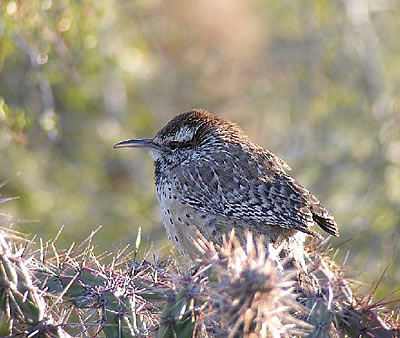
I think of wrens as rather plain small shy songsters that are almost always heard before being seen. The Cactus Wren, Campylorhynchus brunneicapilus, breaks the wren sterootype. It is a good-sized bird (4 times the weight of a Winter Wren), striking in appearance, and raucous in voice, and brash in behavior. Sibley describes the song as "low, grating, chugging, unmusical...". This wren is a common bird of the desert, and is as much a part of the scene as cactus and yucca. We arrived at the Desert Museum in Tucson before it opened, and were entertained by this Cactus Wren in the parking lot! The Cactus Wren ranges from Southern California deserts east to Texas, and well south into Mexico. Note the rufous cap, bold pattern on the wings, and spotting on chest.
Order: Passeriformes - Perching Birds (over 5000 species, i.e. more than 50% of all bird species.
Family: Troglodytidae - The Wrens. 76 species of wrens worldwide, 9 in the U.S. Cactus Wren is easily our largest wren. Thin curved bill is typical of a wren. Wrens often poke around holes for insects, and perhaps this led to the genus name, as a Troglodyte is a caveman, or one who lives in or near holes in the earth. The Wren family may be related to the Old World Warblers and Gnatcatchers, and maybe Creepers.
Genus: Campylorhynchus - The "Cactus Wrens". It means "curved bill". Kind of like a thrasher bill, but thinner. 13 species in this genus, 7 of which are found in Mexico and Northern Central America, but only one in the U.S.
Species: Camphylorhynchus brunneicapilus - Cactus Wren. Populations may have declined as humans populated the deserts.
5. Say's Phoebe - Sayornis Saya
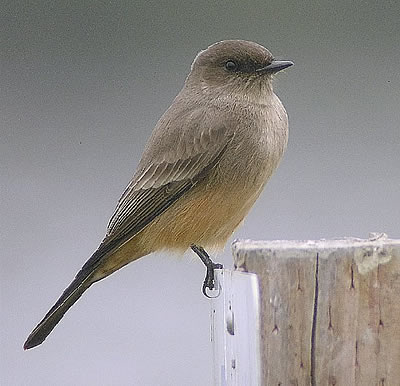
Catching up on photos from December. Seems like this "winter" season has been unusually good for Say's Phoebe sightings, as least at the Las Gallinas ponds. These softly painted flycatchers often pose prominently, as they like an open perch from which to sally forth for prey, usually returning to the same fence-post, or in this case sign-post. Wish I could train them to land on a tree branch, but here the light was good so I couldn't complain. Taken Dec. 3 2008.
6. Pacific Golden Plover
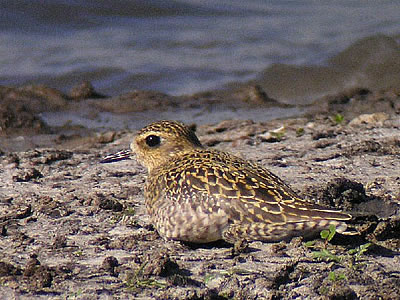
In the Sibley Guide to Birds you'll see three Golden Plovers. They are quite similar to each other, and are built like the slightly larger Black-bellied Plover. The European Golden Plover is not seen on the west coast, and is only rarely seen along the northern East Coast. The American Golden Plover breeds in Alaska and northern Canada, and in fall heads far to the south, mostly traveling through the plains states, but some stopping along the coasts. They don't spend the winter here with any regularity.
The Pacific Golden Plover, Pluvialis fulva, shown here, is a long-distance migrant that breeds in an area from the Yamal Peninsula in eastern Russia over to western Alaska. Most birds head south in long oceanic flights and winter on many islands in the Pacific. Some birds fly down the West Coast and spend the winter in coastal California. Shollenberger Park is probably the best spot to find them locally, but we have also seen a few on the Outer Point, Bodega Bay, and in the valley (Robinson road, south of Davis).
Here we get a look at the warm yellow-gold wash on the face and supercilliary, as well as the golden edges of the scapulars and wing coverts. Can't see the tail well, a feature which helps separate Pacific from the American Golden. The wingtips on the Pacific barely extend beyond the tail tip, although I read this feature can be variable. American Golden's wingtips project more beyond the tail tip.
Short taxonomy - Only four species in the genus Pluvialis, namely the three Golden Plovers, plus the Black-bellied Plover. Older texts show only three Pluvialis, as the Pacific and American Golden Plovers were once considered a single species.
7. White-billed Diver (Gavia adamsii)
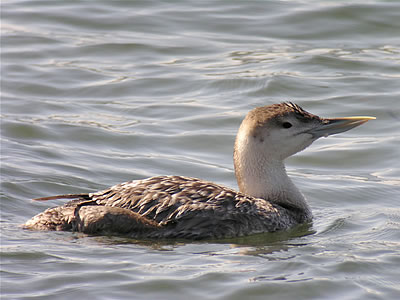
In Europe (and Asia), the Yellow-billed Loon (Gavia adamsii) is known as the "White-billed Diver". In fact across the pond they prefer the name "Diver" to Loon for all five Gavia species.
There are probably less than 10,000 Yellow-billed Loons, the majority in Eurasia, and only a handful make it down the west coast east year. Something special this year, as at least four individuals have been spotted in California. Locally we saw one in Bodega Bay, a juvenile with a very large and "open" bill, and more recently two individuals in Tomales Bay at Nick's Cove. I spent several hours with Fred Hansen observing the latter two feeding. In Tomales Bay they seemed to forage mainly in shallow water for crabs, rather than spend time chasing about for fish. Maybe the local abundance of sand crabs will encourage them to return next year! One YB was an hatch-year bird, and the other a larger-billed adult. It was apparent that Yellow-billed Loons hold their bills higher than do the Common Loons, more in the manner of the Red-throated Loon. Another feature that makes them easier to distinguish from the Common Loon is the large amount of white on the head and neck. And of course then we have the large the pearly yellow dagger of a bill! Common Loon may have a gray or light-tipped bill, but the top of the bill (culmen) is always black.
8. Northern Rough-winged Swallow
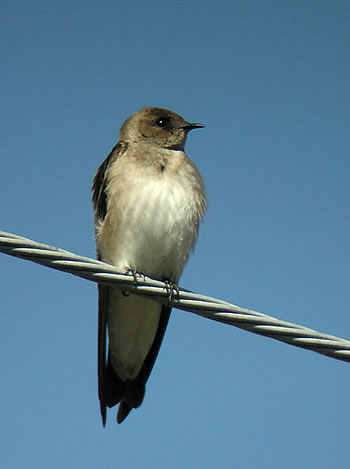
We saw this single Northern Rough-winged Swallow (Stelgidopteryx serripennis) on a wire along Putah Creek in Solano County. Latin name roughly translates as "scraper-wing saw-winged", referring to the structure of the outer primary wing feather:
(from Birds of North America On-line #234, M.J. De Jong) "This swallow’s most distinguishing characteristic is its “rough” primary feather, from which its common name has been derived (see Fig. 6). In adults the stiffened barbs of the leading web of the outer primary feather lack terminal barbules. In males the barbs are recurved into minute hooklets, and in the female they are prolonged into a definite, naked point that is little or not at all recurved. In males this produces “a file-like roughness when the finger is drawn along the edge of the quill from base toward tip” (Ridgway 1904)."
This swallow is easy to miss, it is often and lost in the general swirl of other swallows. They don't congregate like most swallows, and even nest singly in burrows and holes along banks. They have to find a suitable hole, so if there are none available then breeding will be limited. Said to be the least numerous of the North American swallows, and "yes", there is a Southern Rough-winged Swallow in South America. The relationship of the Rough-winged to other Swallows remains indeterminate.
The bird is overall brown on top, with smudged underparts and dusky throat. The blurred look to the photo is due in part to the plumage, as the wire perch is indeed sharp.
9. Marsh Wren - Cistothorus palustris
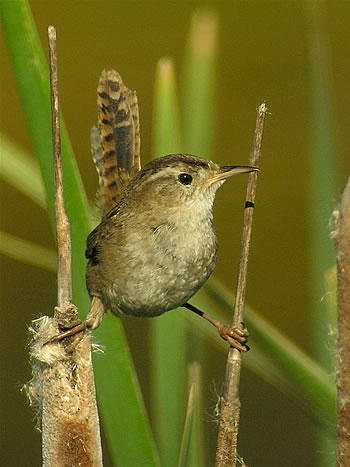
The scientific name of the Marsh Wren translates roughly as "Marshland Rock-rose leaper" (Holloway). Somehow that doesn't tell me much. The Marsh Wren is an interesting species. The male often has one than more female partner (polygyny), and he builds many nests in the area he patrols, creating "dummy" nests as sites to confuse predators, to provide a resting place for himself, etc. They are prolific songsters, with the western race learning over 100 tunes, and they sing incessantly when "on territory", which happens to be right now. He will often counter-sing with a neighboring male, kind of like dueling banjos. Many listeners find the quality of the songs a bit harsh, and describe it rather bluntly as unappealing, but what they may lack in tonal quality is more than made up for by diversity of repertoire. See BNA-OL, #308, Kroodsma and Verner for background. They note that we may see a split between the Eastern and Western Marsh Wrens. Ours learn a lot more songs, but sing less sweetly.
This male was singing recently at the Las Gallinas ponds (east end of pond #1). Would like to give huge thanks to Don Reinberg, whose fine photos of him inspired me to go out and see what I could get.
Taxonomy
Order: Passeriformes (Perching Birds/Songbirds)
Family: Troglodytidae - The Wrens. 76+ species
Genus: Cistothorus - 4 species. One very similar species is the Sedge Wren.
Species: Cistothorus palustris - Marsh Wren.
10. American Avocet - Recurvirostra americana
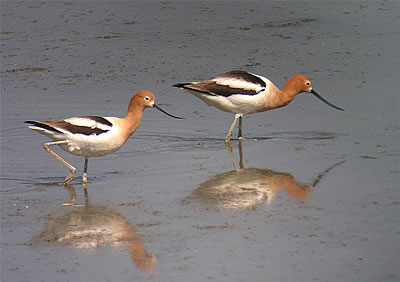
In spring the elegant American Avocet (Recurvirostra americana) raises the esthetic bar to heights few birds can match, as a deep orange glow spreads over head and neck. We never get tired of looking at (and photographing) these creatures. Lucky for us in the Bay Area that we can see them year round, and many migrate south for the winter and inland for breeding. They have largely disappeared from the eastern U.S., except for Florida.
The pair shown here nicely illustrates the differences in the sexes. The male American Avocet (on the right) is larger by 10%, with a bill that is slight longer and less up-curved. They often pair before or during migration, so we don't know if this pair will nest locally. Taken at the Las Gallinas ponds today. The photo may be a bit darker than reality, but it emphasizes the striking orange, so I left it alone.
Taxonomy
Order: Charadriiformes - Shorebirds, Gulls, Terns, et. al.)
Family: Recurvirostridae - Avocets and Stilts. Found in many parts of the world, yet there are only 6 Stilt species and 4 Avocet species.
Genus: Recurvirostra - Avocets. Besides the American Avocet, there are Pied, Red-necked, and Chilean Avocets.
Species: Recurvirostra americana - American Avocet. Good place to observe them nesting in the coming weeks is Shollenberger Park in Petaluma. Stop in and say "Hi" to the folks at PRBO Conservation Science headquarters at the south east corner.
TOWHEE.NET: Harry Fuller, 820 NW 19th Street, McMinnville, OR 97128
website@towhee.net